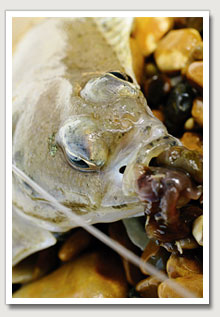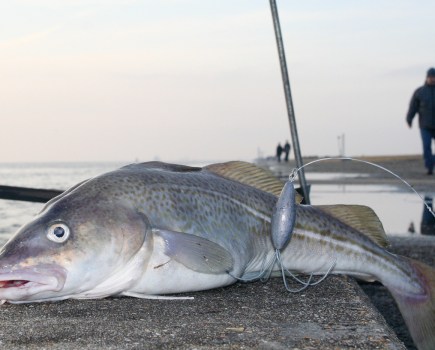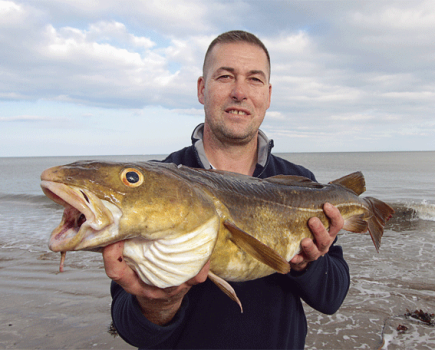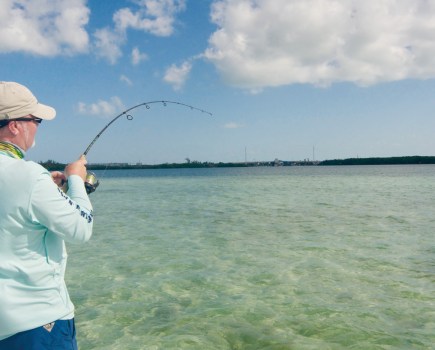The paternoster has a religious connection. It’s an ancient word referring to the recital of the Lord’s Prayer, as well as an item of fishing tackle on which short lines with hooks are attached at intervals to the mainline. Here Alan Yates fishes a paternoster against a boom…
TERMINAL TACKLE IS complicated enough for beginners due to all the different accessories and terminology, but a consistent design thread runs through sea rigs and that’s the paternoster.
It is the most effective and efficient tangle-free rig design, which is why it has withstood the test of time. It can be made of metal or monofilament line, and while the brass paternoster has disappeared it has been replaced by one made from mono line, or one with a mono body and short metal or plastic boom. The basic design is as it always was – only the accessories used to construct it have changed.
MONO PATERNOSTER
UP to 20 years ago mono paternosters included hook snoods attached via lasso loops or snood knots to the rig’s mainline. Some anglers still use this method. The same style was used by commercial fishermen on their set or lay lines, and these contained hundreds of hooks.
Nowadays hook snoods are tied to small swivels trapped on the rig’s mainline with small beads and crimps, or, in some cases, stop knots made from monofilament line or Power Gum.
The rig was originally constructed using one, two or three hooks, simply because three was a practical maximum for casting comfortably, and up to modern times three hooks remain the standard maximum number used in all kinds of angling.
The biggest change in the rig’s construction was instigated when casting distance became a priority. Rig designs now include hooks and snoods that are clipped behind the lead weight or to the mainline to improve the aerodynamics of the baited rig.
 However, the basic paternoster without bait clips, called the flapper, remains the same. The name ‘flapper’ comes from the fact that the hooks and snoods flap around during the cast, cutting distance. You can alter the rig’s aerodynamics simply by reducing the number of hooks – one baited hook will cast much further than three. Other ways to increase casting distance without adding bait clips is to reduce the length of the hook snoods – a shorter, stubby rig with short snoods will cast further.
However, the basic paternoster without bait clips, called the flapper, remains the same. The name ‘flapper’ comes from the fact that the hooks and snoods flap around during the cast, cutting distance. You can alter the rig’s aerodynamics simply by reducing the number of hooks – one baited hook will cast much further than three. Other ways to increase casting distance without adding bait clips is to reduce the length of the hook snoods – a shorter, stubby rig with short snoods will cast further.
The construction of the basic mono paternoster includes a clip or swivel at the top to connect it to the reel’s mainline. This makes it easy to swap rigs and to remove them to help untangle crossed lines.
The lead weight is attached to the bottom of the rig via a quick-release clip, or lead link. This enables you to swap leads easily, and is a stronger joint for the line. Tying the line directly to the lead weight’s eye can allow it to be damaged by abrasion, so this is best avoided.
The snoods come off small swivels spaced at intervals down the rig. There is a tendency to put the longest snoods at the top of the rig, because these are the furthest from the sea bed when the rig is used owing to the angle between the lead weight and rod tip.
There are several variations of the mono paternoster and these include rigs with one, two or three hooks above the lead weight, as well as those with the lower hook hanging below the lead via a swivel close to the lead link. A combination of the two is called a one-up, one-down rig.
Rigs can be stored on rig winders or in sealed plastic bags and labelled, both inside a rig wallet.
BOOMS
THERE are a few anglers who believe metal booms offer some kind of attraction to fish due to the creation of a magnetic field in saltwater. Lots of fish species hunt their prey via the minute magnetic field that crabs and shrimps give off, and the reaction of metal in sea water produces such a minute magnetic pulse.
It’s an opinion as daft to some as using WD40 on your hookbaits, but many believe that as well, so it’s up to you to make up your own mind.
However, small metal booms (6-9in long) are great for producing balanced terminal rigs with longer tangle-free snoods, especially when small diameter mono is preferred.
They also add weight to the rig and nail it to the sea bed, which is another important aspect on many occasions, especially in a strong tide.
The construction of a boom paternoster is similar to the mono paternoster, with the booms trapped between beads and crimps.
Some of the booms available, such as those from Gemini, come complete with tension springs that fit underneath the boom on the rig’s mainline and, when tensioned, keep the boom standing out prone from the rig body.
A small swivel fitted to the eye of the boom can help prevent line twist, caused by small fish, damaging the snood line.
Plastic booms may not have the same magnetic attraction as metal, but they too prevent tangles.

Small 6-9in metal booms are great for producing balanced terminal rigs with longer tangle-free snoods
RIG RULES
● In all cases the main body line of the rig should be strong enough to take the force of casting. The rule of 10lb per ounce of lead weight is ideal for this.
● Hook snoods can be as light as you wish using booms, but with a mono paternoster take care not to use line that is too light because this can twist and tangle more easily. Rigs using ultra-light line can be made to perform more efficiently by reducing swivel sizes and lengthening hook snoods – proportional lengths and line diameters are the major rule.
● Sequins and beads are used as both attractors on hook snoods and to keep the bait close to the hook. They add weight to a hook snood and can help to prevent it tangling.
● Remember, if you want to make hook snoods longer, the rig’s body length needs to be increased. Standard length of a three-hook mono paternoster is 6ft, while modern long rods (15ft-plus) allow that length to be increased.
● You can construct a three-hook paternoster rig using only the three-turn Grinner knot.
JARGON BUSTER
TERMINAL RIG: The tackle anglers use at the end of their line, including lead weight and hooks.
SET OR LAY LINES: Commercial fishing methods of laying a line with hooks placed at intervals and leaving it to fish overnight.
CRIMPS: Small, soft metal sleeves that fit on the rig body line and are squeezed gently so that they grip the line and hold beads and swivels in a set position.
STOP KNOT: A knot (usually a three-turn Grinner) formed in mono or Power Gum on the rig’s mainline to hold beads and swivels in position.
POWER GUM: A strong rubber line used to tie stop knots. It does not wear as quickly as mono and can be moved up and down the rig line to adjust hook positions.








